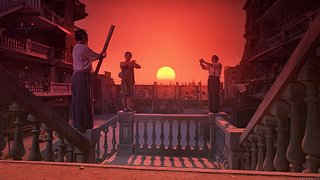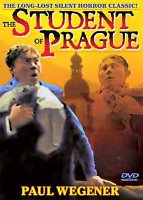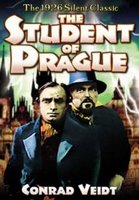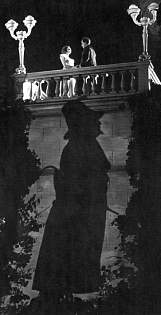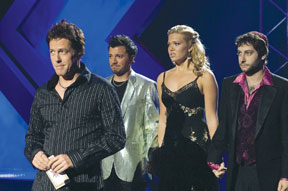Go For Broke!
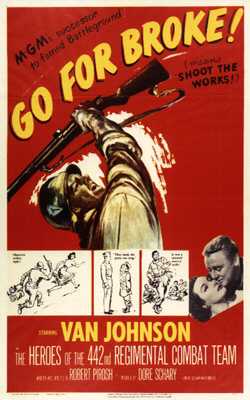
World War II movies have a general feel and tenor to them. They can be occasionally moving or amusing, but the bulk of them remain Sunday afternoon TV-time-filler, and most of us can’t really remember the names or specifics of most of the ones we’ve seen.
They even share a basic plot arch. A platoon of “regular Joes” make up a rag-tag and endearing bunch, usually comprising of an Irishman, a Southerner, a Jewish student-type, a generalized “big brother” Natural-Leader-type, an Italian guy, and possibly a Greek (maybe even with an accent). Their lieutenant seems distant and/or displeased with them, and they resent how hard he is on them. Eventually, after a short time somewhere in the middle of Missouri, they finish Basic Training and are off to Europe, or possibly the Pacific Theatre. Banding together, and relying on the training they once rebelled against (which now saves their lives), they triumph and win the approval and comradeship of their commanding officer. Usually there is a WAC thrown in for a scene or two, perhaps someone sings a song, there is usually a bar fight at the USO, and oftentimes a squad is cut off from the main unit. In the end, they all sail home into New York harbour with bands playing, and everyone is wiser then before, as they mourn the loss of at least one strategically placed character we have come to know over the previous 70 or 80 minutes. (He, of course, represents all the dead sons, brothers and beaus of the original audience, and serves as a meager attempt to bring home the “reality” of warfare.)
Oh, and there is a requisite number of uses of the terms “Gerry,” “Kraut,” and “Jap.” Probably enough to make anyone born post-70 squirm in our chairs.
In many ways, Robert Pirosh’s Go For Broke! (1951) is quite standard. There is a love interest, albeit only in a photograph (“My girl back home"), and people do sing (although not in the typical way). And there certainly is a rag-tag platoon with a by-the-book CO who must learn to appreciate them. There is even an Irishman… of a sort.
Go For Broke! tells the remarkable story of the U.S. 442nd Regimental Combat Team (along with the 100th Infantry Battalion) that was formed in 1943 under a special presidential order, as a kind of experiment in conceptual nation building. It tested Roosevelt’s assertion that Americanism was not a matter of race, but of loyalty and spirit. The 442nd, whose motto was “Go For Broke!”, was entirely manned by Japanese-American volunteers. They suffered over 9000 causalities and earned more than 18,000 individual decorations. Fighting in Europe (so as to avoid being mistaken for the enemy in the Pacific), these men participated in the liberation of Italy and France, and their story fascinates, but is seldom heard.
In the film, we get to know a handful of the volunteers – adorable Tommy (Henry Nakamura), the Pearl Harbor orphan; Sam (Lane Nikano), the wise and friendly Every Man; Chick (George Miki), the bitter and streetwise tough-guy (who for the life of me brings Cory Feldman to mind in every scene); Ohara (pronounced O’Hara throughout; Henry Oyasato), the “suntanned Irishman.” There are also a handful of other characters who weave in and out, such as the fun-loving and ultra-cool Hawaiian beach-bums (who are constantly singing). One of the most touching men is a soft, bespectacled and scholarly young man who loves cats and architecture, but whose degree in engineering has netted him a career as a fruit vendor due to the racial prejudice of the 40s. All in all, these characters are delightful and intimately sketched. Whereas many war movies can rely on ethnic tropes to convey character, this film must flesh out the men for they are all “Japanese,” but certainly not the type we have been trained to expect in such films.
Leading them is Lt. Mike Grayson (Van Johnson, the tallest and blondest star they could find), a lanky Texan who “signed up to fight the Japs, not fight with them.” Over the course of the picture, he comes to realize that it is the Japanese-Americans (Nisei, or Buddha-heads) who symbolize true American values, and that prejudice has no place in a democracy.
However, I must note that this film is certainly not preachy or trite, and it maintains no glossy image of America or the culture of the front. In the 1940s, War films tended to portray Americans as “one big happy family,” because prejudice was contrary to the war effort. However, common sense will tell you that there was certainly racism on the front. This film opens that up and explores it. This is not done through direct and corny exposition, but by poignant illustration of some sliver of what these men went through. They fought enemies on both sides of the front.
I think that few of us can fully comprehend the reality behind this picture; the cruelty of a system in which a man is distrusted and maligned, even while fighting for his country. The same country, by the way, that has locked his mother and father (and friends, and girlfriend, and little brother, and himself) up in internment camps back home, simply for being of Japanese origin. And Go For Broke! explores why a man would volunteer to die for such a country, and the answers are thought-provoking, human and touching.
All in all, this movie adds a new mode of awareness, and, while it is essentially a War Picture (with all the formula that genre entails), it is one that stands out as an exceptional one. On top of that, as a film, I found it gripping in parts, and I actually cried in one scene. While some of the power diminished in subsequent viewings, I find that this movie has lingered with me for some time, and is far more memorable than its cohort. I can see no better reason to recommend a picture than that.


